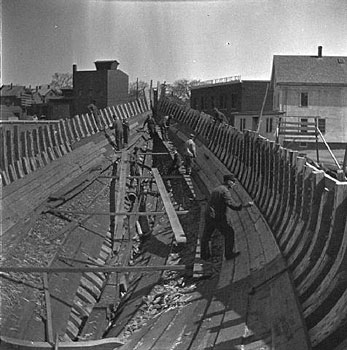The Shipyard
At Front and Water streets, the air smelled of salt water, hot tar, and paint. Oxen delivered cut oak trees from the countryside to the shipyard. Men sorted timber by type and purpose. They let freshly cut wood dry in the sun, but this was a time-consuming process and shipbuilders often chose to work with "green" or fresh-cut wood.
Building a whaling vessel required many skilled laborers. Hewers and shapers transformed logs into square planks and beams that became the frame of the ship. Augermen bored holes and drove in metal and wooden nails. Caulkers packed twisted and tarred yarn called oakum into the seams between planks. Ship's carpenters hammered copper sheathing onto hulls to keep out marine boring worms. Finally, joiners, cabinetmakers, painters, carvers, and polishers furnished and finished the ship's wooden interior.

New Bedford Whaling Museum